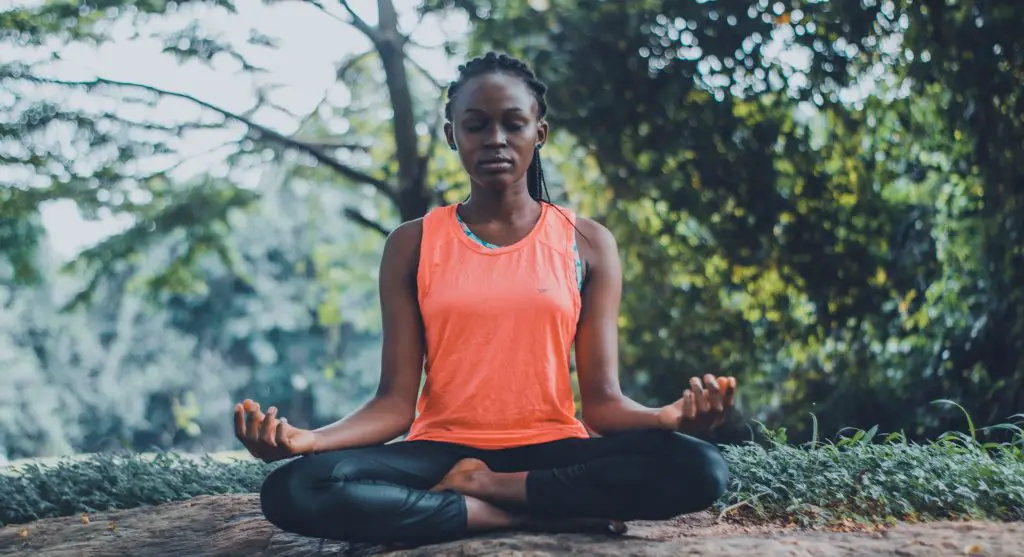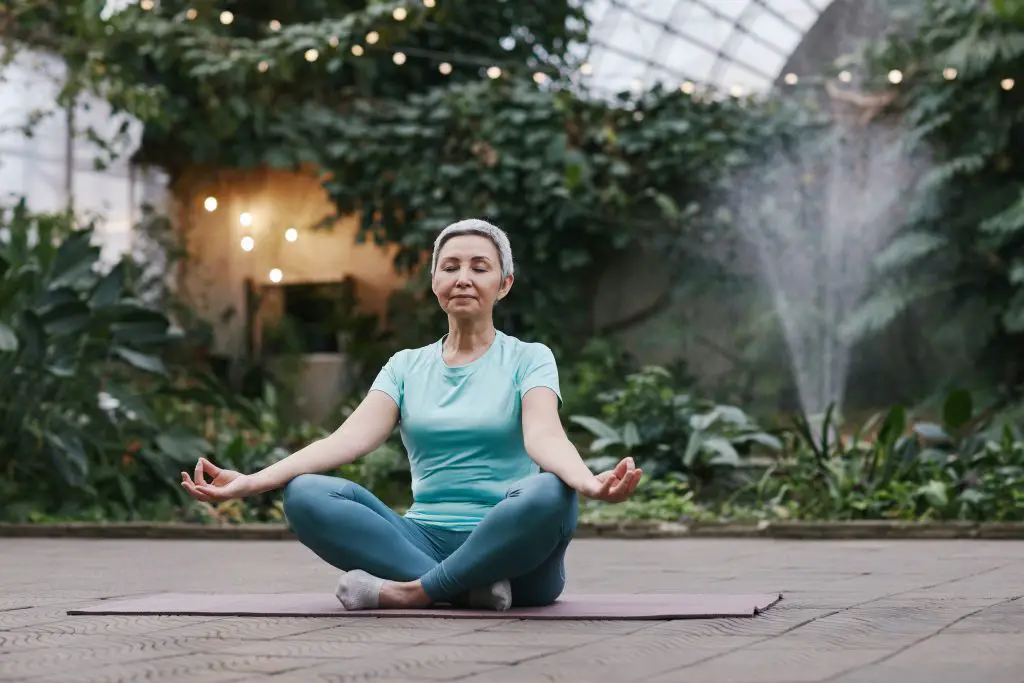Vedic Meditation is an ancient technique that traces its roots to the Vedas, the foundational texts of yoga and Ayurveda in Indian culture. Unlike Buddhist mindfulness-based approaches, Vedic Meditation utilizes a mantra to help settle the mind, promoting deeper relaxation and self-awareness.
Through the practice of Vedic Meditation, individuals can experience a range of benefits such as reduced stress, increased energy, and heightened productivity in their professional lives. The technique involves using specific Sanskrit phrases, which have been used for thousands of years, as a therapeutic resource in daily sadhana practice by yogis around the world.
Typically, Vedic Meditation is taught in person, with a gratitude ceremony as part of the learning process. The calming and centering effects of Vedic Meditation make it a popular choice for those seeking inner peace and better control over their reactions to life’s challenges.

Origins of Vedic Meditation
Vedas
Vedic Meditation traces its roots to the Vedas, ancient Indian texts dating back to around 1500 BCE. These sacred texts encompass a vast body of knowledge, including meditation practices that were passed down orally for centuries before being documented.
Hinduism
As a fundamental part of Hinduism and its spiritual traditions, Vedic Meditation is deeply embedded within the religion’s history. Hinduism has revered these ancient texts as sacred scriptures since ancient times, and thus the practice of Vedic Meditation has been intrinsically linked to the faith.
Swami Brahmananda Saraswati
Swami Brahmananda Saraswati, a revered spiritual teacher of the 20th century, played a significant role in popularizing Vedic Meditation across the globe. His teachings stressed the importance of preserving these ancient meditation techniques and sharing their transformative benefits with practitioners all over the world.
Basic Techniques and Principles

Mantra
Vedic Meditation uses a specific type of mantra called a bija mantra. A bija mantra is a simple, short syllable or sound that does not have any specific meaning to the practitioner. The purpose of using a mantra is to help the practitioner’s mind settle and become more focused.
Effortless Focus
One of the foundational principles of Vedic Meditation is the idea of effortless focus. This technique emphasizes natural and simple meditation, allowing the mind to settle into a state of deep relaxation without conscious effort. Practitioners are encouraged to sit comfortably in a chair with their eyes closed and permit the mind to flow with the repetitive sound of the mantra.
Breathing and Energy
In Vedic Meditation, the focus is not specifically on controlling the breath, but naturally, the breath may become more relaxed and rhythmic due to the calming effects of the practice. As the meditation progresses, some practitioners may experience a sense of increased energy flow throughout their body. This is believed to be the result of the deep relaxation and mental clarity achieved through the practice of Vedic Meditation.
Overcoming Thoughts
Unlike some other forms of meditation, Vedic Meditation does not seek to eliminate thoughts or force the mind into a state of emptiness. Instead, it encourages practitioners to treat thoughts as part of the meditation process. The use of the bija mantra helps to disengage from the thought stream, allowing the practitioner to experience a state of deep rest without fighting or suppressing the natural flow of thoughts.
Benefits of Vedic Meditation

Stress Relief
Vedic meditation is known to lower stress hormones such as cortisol and strike a balance in brain waves. This practice allows for the release of helpful hormones like oxytocin, DHEA, GABA, and melatonin. With regular practice, one can experience the advantages of neuroplasticity, the brain’s ability to adapt and learn from new experiences. This leads to reduced stress levels and better overall mental wellbeing.
Improved Sleep
Regular practice of Vedic meditation can improve sleep quality and help combat insomnia. By activating the parasympathetic nervous system, which governs relaxation and rejuvenation, meditation helps reduce stress chemicals that accumulate in the body, allowing for deeper and more restful sleep. It also acts as a natural alternative to habit-forming or toxic medications commonly used to promote sleep.
Enhanced Awareness
One of the main goals of Vedic meditation is to connect to one’s inner self, leading to enhanced self-awareness. Through this practice, individuals can develop a stronger understanding of their thoughts, emotions, and behaviors. This deeper awareness can lead to improved decision-making, emotional balance, and the ability to better navigate through life’s challenges.
Physical Health Benefits
There are several physical health benefits associated with Vedic meditation, including:
- Reduced anxiety: By managing stress effectively, the practice can alleviate anxiety and its physical manifestations.
- Lower blood pressure: Meditation can help decrease the risk of heart disease by reducing blood pressure and subsequently, the strain on the cardiovascular system.
- Increased serotonin levels: Using mantras or affirmations during meditation can boost serotonin levels, resulting in enhanced mood and self-confidence.
By incorporating Vedic meditation into their daily routine, individuals can gain significant physical, mental, and emotional health benefits, paving the way to overall well-being and increased quality of life.
Vedic Meditation vs. Other Forms

The practice of Vedic meditation can be contrasted with other popular forms of meditation like Transcendental Meditation, Mindfulness Meditation, and Yoga. This section explores the key differences in technique, focus, and benefits of each method.
Transcendental Meditation
Transcendental Meditation (TM) and Vedic meditation share a common origin, with TM being a branded and trademarked form of Vedic meditation, popularized by Maharishi Mahesh Yogi in the US during the 1960s. Both practices use mantra repetition to settle the body and mind, diving into a deep meditative state. Their goals are also similar, aiming to achieve greater peace, calm, and equilibrium for practitioners.
However, Vedic Meditation allows more flexibility in mantra selection and tends to be more accessible due to its openness with teaching methods and affordability, whereas TM often involves costly courses and strict teacher guidance.
Mindfulness Meditation
Mindfulness Meditation is different from Vedic meditation in its approach and focus. Mindfulness Meditation is centered around the development of present-moment awareness and nonjudgmental observation of thoughts, feelings, and bodily sensations. Instead of using mantras, the focus is on the breath or bodily sensations as an anchor for the wandering mind.
Vedic meditation, on the other hand, involves the repetition of mantras to achieve a deep, restorative state of meditation. The purpose of Vedic Meditation is to allow the mind to settle into a calmer and more unified state, whereas Mindfulness Meditation aims to cultivate a continuous, mindful awareness of the present moment throughout the day.
Yoga
Yoga is another practice that differs from Vedic meditation, even though both have roots in ancient Indian spiritual traditions. Yoga incorporates physical postures, breath control, and meditation techniques to promote physical and mental well-being. There are various forms of yoga, such as Hatha, Ashtanga, and Kundalini, each with its unique approach and focus.
On the contrary, Vedic meditation primarily emphasizes on using mantras to achieve mental and emotional balance. Practitioners of Vedic meditation can benefit from combining it with Yoga to enhance the overall meditative experience and cultivate a holistic approach to well-being.
Learning Vedic Meditation
Vedic Meditation is an ancient technique that offers numerous benefits, including improving health, reducing stress, and promoting mental clarity. To master this practice, individuals can choose from a variety of courses, teachers, apps, and online platforms.
Courses and Teachers
There are several reputable courses available both in-person and online to learn Vedic Meditation. Teachers such as Thom Knoles and Susan Chen offer introductory lectures, detailed explanation of the meditation technique, and practical guidance for implementing Vedic Meditation into daily life.
To become a Vedic Meditation teacher, it is necessary to meet certain prerequisites, like practicing Vedic Meditation consistently for at least two years and completing specific programs, such as Exploring the Veda and Mastering the Siddhis. These courses are designed to deepen the understanding and mastery of Vedic Meditation.
Some known training courses provide comprehensive curriculums that use visualization techniques, breath-work, and mindfulness. These courses can be found online, and often include video lessons, supplementary materials, and community support.
Apps and Online Platforms
With the increasing demand for accessible meditation resources, several apps and online platforms have emerged to make learning Vedic Meditation more accessible. These digital tools offer guided meditation sessions, instructional content, and tailored meditation plans to suit individual needs and schedules.
Apps such as FLOW Meditation provide engaging and detailed lessons on meditation, enabling students to learn at their own pace. Moreover, these apps feature user-friendly interfaces, audio and video guidance, and supplementary materials to help in practicing and mastering Vedic Meditation.
Online platforms dedicated to the study and practice of Vedic Meditation offer a wealth of resources, giving learners the flexibility and convenience of accessing course content from anywhere, at any time. This ease of access allows individuals to create a sustainable and consistent practice that fits their lifestyle.
Implementing Vedic Meditation into Daily Life
This ancient technique from India, has gained popularity for its calming effects and ability to create a more focused life. Implementing this practice into daily life can seem daunting, but with the right approach, it can become an essential part of a healthy routine.
Building a Daily Habit
To establish Vedic Meditation as a habit, consistency is key. Set aside a specific time each day, ideally twice, for your practice. It is recommended to meditate for 20 minutes to receive the maximum benefits. This could be in the morning upon waking and in the evening before dinner or bedtime.
Creating a dedicated meditation space can also help reinforce the habit, whether it is a corner of a room or a dedicated sanctuary. Having a peaceful and comfortable environment can contribute to the overall meditation experience.
Tips for Busy People
For those with busy schedules, incorporating Vedic Meditation into daily life might seem overwhelming. However, with some adjustments, it can become possible to fit meditation sessions into a hectic routine:
- Consider shorter sessions: If 20 minutes seems too long, start with 10 minutes and gradually increase the duration as you grow more comfortable with the practice.
- Utilize spare time: Take advantage of small pockets of time, such as during a lunch break or while waiting for an appointment, to meditate.
- Combine with other activities: Try pairing meditation with other daily routines, such as just after waking up or before bed, to make it a natural part of your day.
Combining with Other Mindfulness Practices
Vedic Meditation, which uses bija mantras or vibrational sounds, can be combined with other mindfulness practices to enhance the overall meditation experience. Some options include:
- Yoga: Practicing yoga before meditation can help prepare the body and mind for a deeper meditation experience.
- Visualizations: Along with mantra repetition, try incorporating visualizations to create a more immersive meditative state.
- Breathing exercises: Focusing on the breath while repeating the mantra can help deepen concentration and promote relaxation.
By carefully integrating Vedic Meditation into a daily routine, people of all lifestyles can benefit from its calming effects and increased clarity of mind.
Notable Endorsements and Success Stories
Celebrities
Vedic meditation has garnered the attention and support of numerous celebrities. Renowned musicians such as The Beatles and The Beach Boys practiced meditation, finding inspiration and inner peace through its principles. Other celebrities, including Katy Perry, Paul McCartney, and Oprah Winfrey, also benefit from regular meditation, experiencing positive improvements in their personal lives and careers.
Athletes
High-performance athletes often deal with significant pressure, both on and off the field or court. Many turn to Vedic meditation to cope with the mental demands of their professions. NBA players, in particular, have credited meditation with helping them manage stress, enhancing focus, and achieving mental balance, all of which contribute to improved athletic performance.
High-Performance Professionals
Meditation is not limited to the worlds of entertainment and sports. High-performance professionals across various industries also rely on Vedic meditation to boost their cognitive abilities and maintain mental well-being. By incorporating this ancient practice into their daily routines, these individuals often report a reduction in stress and anxiety, better sleep, and overall improvements in productivity and decision-making.
Beyond Personal Practice: Vedic Meditation and Society
Vedic Meditation, a practice rooted in ancient Indian culture, has transcended its original use as a personal relaxation technique and expanded its positive impact on society. This particular section explores the far-reaching benefits and initiatives that evolved from Vedic Meditation’s principles and teachings.
World Peace Initiatives
Vedic Meditation has influenced various world peace initiatives, as its practitioners recognize its inherent potential to cultivate inner peace and promote harmony amidst diverse populations. These initiatives strive to attain global tranquility and understanding by fostering positive interpersonal connections and encouraging individuals to develop a deeper awareness of their mental states.
One notable example is the World Peace Group, an organization dedicated to promoting inner peace through meditation. This group has established a network of ‘Peace Palaces’ in different countries where individuals can come together to practice meditation and participate in other courses and programs that cultivate personal growth and well-being. By facilitating these spaces for collective meditation, the World Peace Group aims to create a ripple effect of positivity that extends from individuals to the wider community and ultimately, the world.
Impact on Technology
The principles of Vedic Meditation have also made a significant impact on technology. Meditation technologies, such as wearable devices and smartphone applications, have used the core concepts of Vedic Meditation to help individuals track their progress, establish customized routines, and receive personalized guidance. These tech advancements have made meditation more accessible to the masses and enhanced its effectiveness as a stress-reduction tool.
Furthermore, innovative platforms leveraging artificial intelligence and virtual reality have been developed, allowing users to experience immersive meditation environments that facilitate relaxation and deep focus. By integrating these techniques into the realm of technology, more individuals can reap the benefits of this practice, making it an integral component of modern society.
Consciousness
Vedic Meditation has played a critical role in raising consciousness and awareness within society. As mindfulness becomes increasingly important in fast-paced, modern lifestyles, people are turning towards these practices to ground themselves and gain clarity.
This heightened consciousness extends beyond personal growth and fosters empathetic communities, capable of understanding and respecting diverse perspectives. Through this expanded awareness, society can make positive changes, working together to create a more harmonious world that is open-minded and respectful of individual differences.
Here is a video on Vedic Meditation:
